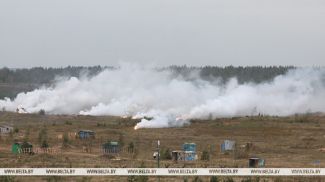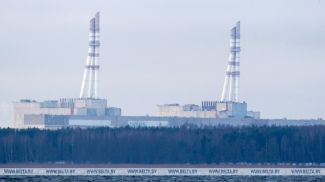MINSK, 14 January (BelTA) – Various ways of handling spent nuclear fuel of the Belarusian nuclear power plant are available. Some of them were mentioned by Deputy Chief Engineer of the state enterprise Belarusian Nuclear Power Plant Alexander Parfenov during the meeting held on 14 January to discuss with the general public an ecological report on the strategic ecological evaluation of the Belarusian nuclear power plant's spent nuclear fuel management strategy, BelTA has learned.
Alexander Parfenov said: “The choice of handling spent nuclear fuel is unique for every country. The choice is affected by multiple factors. Apart from that, the final decision depends both on the country's capabilities and commitments as well as the services foreign partners offer. The main factors influencing the choice are prospects of development of the nuclear energy industry, the possible potential amount of spent fuel, the availability of raw materials of one's own, the availability of fuel resources, geographical location, geological structure of the territory, the resolution of environmental problems, economic advisability, and so on. All of them have to be taken into account in the course of developing the national strategy. The government has decided to authorize a technical and economic evaluation of the possible ways of spent nuclear fuel management in order to choose the main options out of the entire multitude.”
As a result of the technical and economic evaluation they have decided in favor of getting the Belarusian nuclear power plant's spent nuclear fuel processed in Russia and storing the resulting waste in Belarus as a high-priority option. The waste will contain radionuclides of the cesium-strontium variety except for long-lived radionuclides. Three main variants, which are subject to strategic ecological evaluation, were mentioned, said the deputy chief engineer of the state enterprise Belarusian Nuclear Power Plant.
Two variants provide for sending irradiated fuel rod arrays to Russia for processing and storing the resultant high-active waste in Russia or in Belarus for a long time and then returning and burying high-active waste in Belarus. One variant provides for storing waste in Belarus without sending it to Russia. If spent nuclear fuel is sent to Russia for processing, Belarus will not have to build deep burial sites of its own.
“The day after or even exactly when the fuel rod is inserted into the active zone, it becomes spent nuclear fuel. It will be classified exactly as such,” explained the deputy chief engineer. “But the fuel rod will work for four years in the active zone to be put into cooling ponds afterwards. To put it short, we intend to get the first spent fuel in four years.”
Spent nuclear fuel still generates residual heat, this is why transporting it is not a simple matter. Spent nuclear fuel has to stay in cooling ponds for approximately ten years.
The Belarusian nuclear power plant is being built near Ostrovets, Grodno Oblast using a Russian design featuring two VVER-1200 reactors with the total output capacity of 2,400MW. The first power-generating unit is scheduled for commissioning in 2019, with the second one to go online in 2020.













